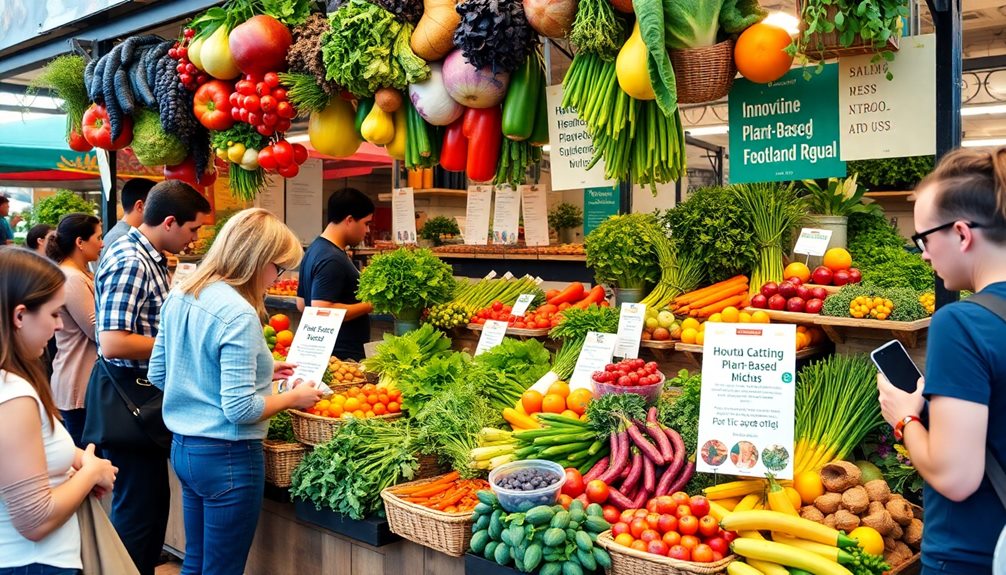Plant-based menu trends are changing the dining scene, driven by younger consumers keen to reduce meat intake. You'll find innovative dishes featuring plant proteins, dairy alternatives, and sustainable ingredients, giving you a diverse range of options. Flavor and texture are key, so new techniques like precision fermentation are enhancing your experience. With the market projected to hit $74.2 billion by 2027, restaurants are creating exciting, health-conscious menus that cater to your preferences. Many brands are also focusing on transparency and sustainability to align with your values. Stay tuned for more insights on what's next in plant-based dining!
Key Takeaways
- The demand for diverse plant-based options is rising, with 60% of consumers actively reducing meat consumption, particularly among Gen Z and Millennials.
- Flavor enhancement and texture innovation are crucial for consumer acceptance, driving the development of new plant-based menu items.
- Sustainable ingredient sourcing, including upcycled and alternative proteins, is increasingly prioritized by brands to meet eco-conscious consumer demands.
- Institutional foodservice is expanding its plant-based offerings, promoting sustainability and catering to health-focused consumers seeking diverse meal options.
- Trends in precision fermentation and lab-grown products are transforming plant-based menus, enhancing flavor profiles while supporting environmental goals.
Market Growth and Insights

The plant-based food market is booming, projected to hit $74.2 billion by 2027 with a remarkable annual growth rate of 11.9%. This growth is primarily driven by increasing consumer demand for sustainable food options.
You'll notice that from 2018 to 2022, new plant-based product launches surged by an impressive 302%, showcasing a significant shift towards innovation and diversity in the marketplace.
Young consumers, particularly Gen Z and Millennials, are at the forefront of this trend. Around 60% of them are actively reducing their meat consumption, indicating a strong market segment for plant-based offerings.
The rise of flexitarian diets, with 26% of consumers identifying as flexitarian or meat-reducing, further emphasizes the demand for various plant-based alternatives.
While economic challenges have caused a recent sales slump for some brands like Beyond Meat, the long-term outlook for the plant-based sector remains positive.
As consumer preferences continue to evolve towards healthier and more sustainable food choices, you can expect to see more innovative plant-based products hitting the shelves, catering to the growing desire for flexible and sustainable eating habits.
Consumer Behavior and Preferences

With a notable shift in dietary habits, about 60% of consumers are actively cutting back on meat, driven largely by younger generations like Gen Z and Millennials. This change in consumer behavior highlights a growing preference for plant-based options, primarily motivated by health benefits.
In fact, over 75% of German youth regularly consume plant-based foods, indicating a strong trend toward nutritious diets.
To better understand this shift, consider these key factors influencing consumer choices:
- Taste and Texture: These are the top factors driving plant-based purchases, emphasizing the need for product innovation.
- Dietary Principles: Nearly 50% of consumers adhere to specific diets, with 26% identifying as flexitarian or meat-reducing, signaling a demand for diverse plant-based offerings.
- Whole Foods Preference: A significant portion of consumers, about 49%, expresses concern over the processing of meat alternatives, showing a clear shift toward whole foods with nutritional benefits.
As you navigate this evolving landscape, it's crucial to recognize these preferences to successfully cater to the modern consumer's demand for plant-based options.
Understanding Plant-Based Products

When exploring plant-based products, you'll find a variety of categories, from meat and dairy alternatives to innovative seafood options.
Understanding their nutritional benefits can help you make healthier choices while enjoying diverse flavors and textures.
Plus, it's fascinating to see how innovations are driving the demand for these products in today's market.
Product Categories Overview
Plant-based products encompass a diverse array of categories, offering alternatives to meat, dairy, seafood, and an expanding selection of snacks, sauces, and beverages. This variety is driven by global trends and an increasing demand for plant-based diets.
Here's a closer look at key product categories you might explore:
- Meat Alternatives: These include innovative substitutes for beef, pork, and poultry, with poultry alternatives seeing remarkable growth at a CAGR of 96% between 2018 and 2022.
- Dairy Alternatives: From oat milk to almond yogurt, these products cater to those seeking non-dairy options, greatly expanding consumer choices.
- Snacks and Condiments: A range of snacks and sauces derived from fruits, vegetables, grains, nuts, and seeds are emerging, providing flavorful and nutritious options.
As you navigate the plant-based landscape, keep an eye on emerging trends that focus on unique identities rather than direct comparisons to animal-based products.
With 29% of consumers now preferring vegetables over meat alternatives, there's a strong opportunity to incorporate plant proteins into your menu, appealing to diverse dietary preferences.
Nutritional Benefits Explained
A variety of nutritional benefits comes with adopting a plant-based diet, making it an appealing choice for many. One considerable advantage is the high fiber content found in plant-based foods, which enhances digestion and contributes to overall health outcomes. This fiber-rich diet can lower your risk of chronic diseases like heart disease, diabetes, and certain cancers.
You'll also find that plant-based proteins can provide essential amino acids comparable to those in animal proteins, supporting your muscle recovery and growth without the added saturated fats. This makes it easier for you to maintain a balanced diet while enjoying delicious meals.
Moreover, plant-based diets promote environmental sustainability. By reducing your consumption of animal products, you can considerably decrease your carbon footprints—livestock farming accounts for 14.5% of global greenhouse gas emissions.
Research shows that shifting to a plant-based diet can lower water usage by up to 50% and reduce land use for animal agriculture by 75%, highlighting the ecological advantages of this lifestyle. Embracing a plant-based diet not only benefits your health but also the planet.
Innovations Driving Demand
Innovation is transforming the landscape of plant-based products, meeting the rising consumer demand for diverse and sustainable food options.
As you explore this evolving market, you'll discover how advancements are reshaping the industry, particularly in the area of plant-based meat alternatives.
Here are three key innovations driving demand:
- Technological Innovations: Techniques like precision fermentation and 3D printing are enhancing the flavor and texture of plant-based foods, making them more appealing to consumers.
- Focus on Whole Foods: There's a significant shift toward whole foods and less processed options. Nearly half of consumers express concern over the processing of meat alternatives, leading to a demand for natural, minimally processed products.
- Sustainable Seafood Alternatives: With 60% of UK consumers interested in plant-based seafood, food brands are tapping into this market potential, aiming to address sustainability concerns in the fishing industry.
These innovations not only cater to consumer preferences but also promise to reshape the future of food, driving acceptance and expanding the market for plant-based options.
Embracing these trends can elevate your culinary offerings while promoting sustainability.
Innovations in Product Development

In the world of plant-based product development, you'll find exciting innovations focused on flavor enhancement techniques and sustainable ingredient sourcing.
These advancements lead to unique product formulations that not only satisfy taste buds but also align with eco-conscious values.
As you explore these trends, you'll see how the industry is transforming to meet consumer demands for quality and sustainability.
Flavor Enhancement Techniques
Flavor enhancement techniques are transforming the landscape of plant-based product development, and you might be surprised by how much these advancements can elevate your dining experience.
With 44% of consumers craving better flavor, innovation in this area is vital for market growth and consumer acceptance. Here are three key techniques driving this change:
- Fermentation: This age-old process is being harnessed to boost taste and nutritional profiles, creating unique flavors that set products apart. Companies like Planet A Foods are leading the way with cocoa-free chocolate crafted through fermentation.
- Texture Agents: Innovations in texture agents are important for mimicking the mouthfeel of traditional dairy and meat products, enhancing the overall eating experience of plant-based foods.
- New Technologies: Techniques like 3D-printing and algae-sourced materials are paving the way for exciting flavor profiles and textures, pushing the boundaries of what plant-based products can achieve.
These flavor enhancement strategies not only improve the palatability of plant-based eating but also foster greater consumer acceptance, ultimately driving the market forward.
Immerse yourself in this flavorful future!
Sustainable Ingredient Sourcing
Sustainability is at the forefront of plant-based product development, transforming how ingredients are sourced and utilized. With growing environmental concerns, brands are turning to sustainable ingredient sourcing to meet consumer demands for ethical food options.
Innovations like upcycled ingredients, such as apricot kernels, help reduce food waste while creating nutritious products that appeal to eco-conscious customers. Additionally, the trend of incorporating fermented vegetable plates into menus highlights the use of seasonal produce, enhancing flavor profiles while promoting gut health.
The rise of alternative protein sources, including pea, soy, and mycoprotein, plays a critical role in this movement. These ingredients minimize resource use while maximizing health benefits, making them ideal for plant-based diets.
Major food brands are also investing in lab-grown and extruded products, showcasing technological advancements that enhance sustainability.
Seasonal plant-based offerings are being developed to align with local agricultural cycles, which not only supports regional economies but also appeals to environmentally aware consumers.
Additionally, the increasing interest in plant-based seafood alternatives has led to innovations in sourcing sustainable marine ingredients, addressing both environmental concerns and the desire for diverse, ethical options.
Unique Product Formulations
A wave of innovation is reshaping the landscape of plant-based product development, introducing unique formulations that cater to evolving consumer tastes. As you explore this dynamic space, consider the following trends:
- Fermentation Techniques: Companies are utilizing fermentation to enhance the flavors and textures of plant-based foods. With 44% of consumers seeking better taste in alternatives, this technique is a game-changer.
- Novel Plant-Based Proteins: Innovations in protein sources, like microalgae and 3D-printed scaffolding, are expanding the variety of plant-based alternatives available, making them more appealing as meat substitutes.
- Authentic Dairy Alternatives: The push for plant-based dairy products is strong, with brands focusing on replicating the sensory experience of traditional dairy through new technologies and authentic flavors.
These unique product formulations not only improve nutritional profiles but also promote sustainability within the food system.
Health and Environmental Benefits

Why should you consider a plant-based diet? The health and environmental benefits are compelling. Adopting a plant-based diet can lower your risk of chronic diseases like heart disease, diabetes, and certain cancers. This is largely due to the high fiber content and nutrient density of plant foods, which promote better digestion and overall health.
On the environmental front, changing to a plant-based lifestyle can greatly reduce your carbon footprint. Livestock farming is responsible for about 14.5% of global greenhouse gas emissions. By choosing plant-based options, you contribute to lowering this impact.
Additionally, you can cut your water usage by up to 50%, addressing urgent water scarcity issues.
When it comes to land use, moving from animal agriculture to plant-based systems can reduce the land needed for food production by up to 75%. This not only preserves valuable resources but also contributes to a more sustainable food system.
Marketing Challenges and Strategies

As more people recognize the health and environmental advantages of plant-based diets, brands face unique marketing challenges in this evolving landscape.
To effectively engage consumers, you'll need to adopt strategic approaches that address their concerns and preferences.
Here are three essential marketing strategies to contemplate:
- Emphasize Transparency: Be open about your ingredient sourcing and production processes. This builds consumer trust, especially among health-conscious shoppers who scrutinize what they eat.
- Highlight Environmental Benefits: Use your campaigns to showcase the positive impact of plant-based diets on the planet. With sustainability becoming a priority for many consumers, emphasizing ethical practices can resonate deeply.
- Communicate Health Benefits: Clearly articulate the nutritional value of your plant-based options. Amid rising scrutiny of ultra-processed foods, effective messaging that underscores health benefits can help sway consumer behavior.
However, pricing challenges remain a significant barrier.
Higher-priced plant-based items often get cut from budgets during tough economic times.
Future Trends and Opportunities

The future of the plant-based food market looks promising, with projections estimating its growth to $74.2 billion by 2027. This surge is driven by increasing consumer demand for sustainable options and innovative alternatives. You'll see advancements focusing on unique plant-based offerings that emphasize natural ingredients rather than just replicating animal products.
Here's a quick overview of the exciting trends on the horizon:
| Trend | Impact on Market |
|---|---|
| Precision Fermentation | Enhances taste and variety |
| Institutional Foodservice | Expands access to plant-based meals |
| Cultivated Meat | Long-term innovation opportunities |
As institutional foodservice expands its plant-based offerings, initiatives like two-thirds plant-based cafeterias promote sustainability in schools and corporate settings. Additionally, technologies like microalgae will help cater to consumer demand for better taste and variety. While the acceptance timeline for cultivated meat is estimated at ten years, it opens doors for innovation in the plant-based market, creating a landscape rich with opportunities for those ready to embrace the future. Your choices as a consumer will drive this evolution, shaping the market toward sustainability and health.
Frequently Asked Questions
Why Is Plant-Based Food Trending?
You might notice plant-based food trending because more people are seeking healthier, sustainable options. With rising awareness of health benefits and ethical concerns, it's becoming a popular choice among various demographics, especially younger consumers.
What Is the Plant-Based Food Trend in 2025?
By 2025, you'll witness plant-based food booming like never before! As consumer demand skyrockets, expect innovative, delicious options that cater to your health and sustainability desires, transforming your dining experience into something extraordinary.
What Is Trending Vegan Food in 2024?
In 2024, you'll find exciting vegan options like innovative plant-based seafood, improved dairy alternatives, and seasonal dishes. Flexitarian diets are rising, so you'll enjoy more diverse, convenient meals that cater to your preferences.
What Are the Most Popular Plant-Based Foods?
You'll find oat milk's creaminess contrasts beautifully with almond yogurt's lightness. Meanwhile, hearty pea protein burgers satisfy your cravings just like traditional meat. These popular plant-based foods offer delicious, guilt-free indulgence while supporting a healthier lifestyle.
Conclusion
In the ever-evolving landscape of food, plant-based menus are blossoming like a vibrant garden, attracting diverse tastes and preferences. As you navigate this trend, remember that understanding consumer behavior and innovative products can help you cultivate your own success. Embracing the health and environmental benefits will not only nourish your customers but also strengthen your brand. So, gear up to seize the opportunities ahead and watch your plant-based offerings thrive in this flourishing market.









